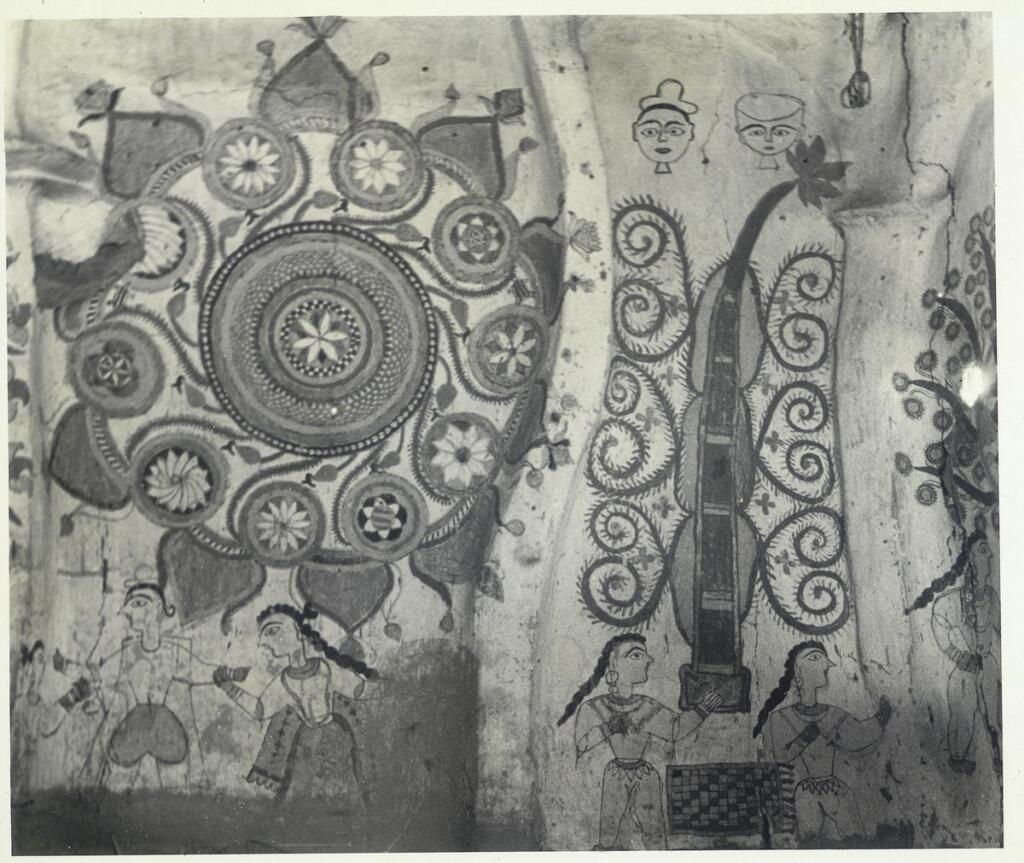
Kohbar ghar, 1935, photograph by William Archer
On January 15, 1934 a deadly earthquake ripped through Northern Bihar, bringing with it loss and devastation. But in the midst of this horror, there came a magical revelation. William Archer, a civil service official stationed in Madhubani, Bihar by the colonial government, noticed that beyond the crumbling walls of houses in ruin stood elaborate wall paintings adorning what had once been inner courtyards. Large lotus ponds with flowers, snakes, fishes, turtles, parrots and peacocks appeared in these lush paintings alongside depictions of Parvati, Shiva, and other gods and goddesses. In keeping with centuries-old traditions of the land, these were paintings created by the women of these households, primarily in the Kohbar-ghar or marriage chambers, as part of wedding rituals.
And that’s the story of how Mithila art was ‘discovered’.
Archer then went on to gather more knowledge about the art form, eventually writing about them in Marg in 1949, laying the foundations for most of our contemporary understanding of Mithila art. Since most of the households he’d first seen the paintings in were Brahmin and Kayastha, he particularly surveyed households from these communities in his later trips and stressed that it was pioneered by these communities. He then went on to interpret the symbolism in these paintings, finding in them metaphors for fertility. Most importantly, in his Marg article, Archer sought to project the paintings beyond their ritualistic meaning, calling out their “inescapable elements of strangeness, the sense of wonder, a mystery burning at the heart of life” — what he considered elements of the finest art.
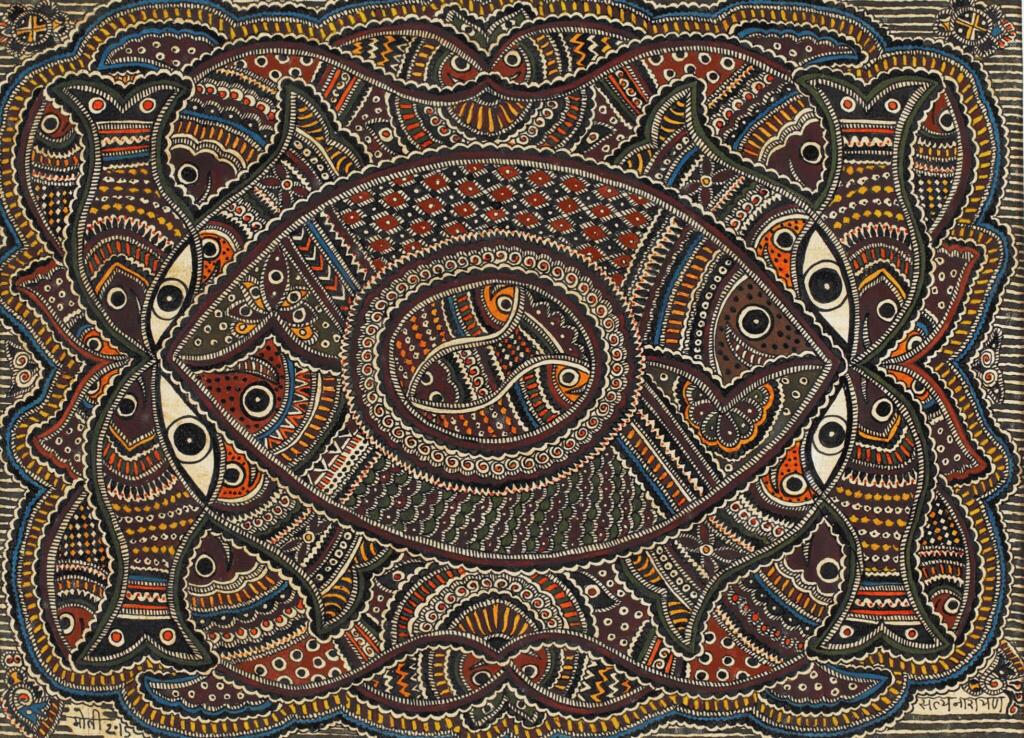
Untitled, 2015, Satya Narayan Lal Karn and Moti Karn ©️Sarmaya Arts Foundation
Wall to paper
While Archer left with about 20 paper versions of the wall paintings he had seen, these served no commercial purpose. Called aides-memoire by Archer, they were meant to preserve some of the images to serve as references for multiple generations of women from each family. It was during Bihar’s notorious famine of 1966-67 that Mithila art found commercial purpose on paper. Pupul Jayakar, chair of the All India Handicrafts Board, had written to Archer years before, asking about where to find Mithila art in order to compile a visual record. When her visit to Mithila in the late 1950s for this purpose didn’t prove fruitful, she enlisted the help of artist Bhaskar Kulkarni in 1966 to track down the paintings.
Kulkarni drove around Madhubani, finally finding himself at the Mahapatra Brahman and Karna Kayastha households of Jitwarpur and Ranti, where some women recreated versions of their wall paintings on paper (women from Shrotriya Brahmin households had refused). Kulkarni’s return with the first paper paintings proved immensely successful. Ganga Devi and Mahasundari Devi, both Kayastha painters, and Sita Devi and Jagadamba Devi, both Brahmin painters found almost immediate recognition and acclaim as some of the earliest masters of the form. This didn’t just change the career and life trajectories of the women, but also increased the scope of the art itself. Consider Sita Devi and Ganga Devi, for whom recognition didn’t just translate to private and government commissions, but also paved the way for trips to represent the country in Japan, Europe, the USSR and the United States in the 1970s. Both artists drew inspiration from their trips for later works — Sita Devi depicting the Arlington National Cemetery and World Trade Centre from her trip to the US and Ganga Devi drawing her hotel in Moscow. With more experiences for the women came wider imagery in the art itself.
While early efforts had targeted particularly women in Brahmin and Kayastha communities with strict pardas, the artists to emerge as masters of Mithila painting spanned across several caste communities – including artists such as Lalitha Devi, Chano Devi and Shanti Devi from the Dusadh community, and Jamuna Devi from the Chamar community. We also saw the emergence of male artists like Santosh Kumar Das, Batohi Jha, his brother Krishnanand Jha and Gopal Saha.
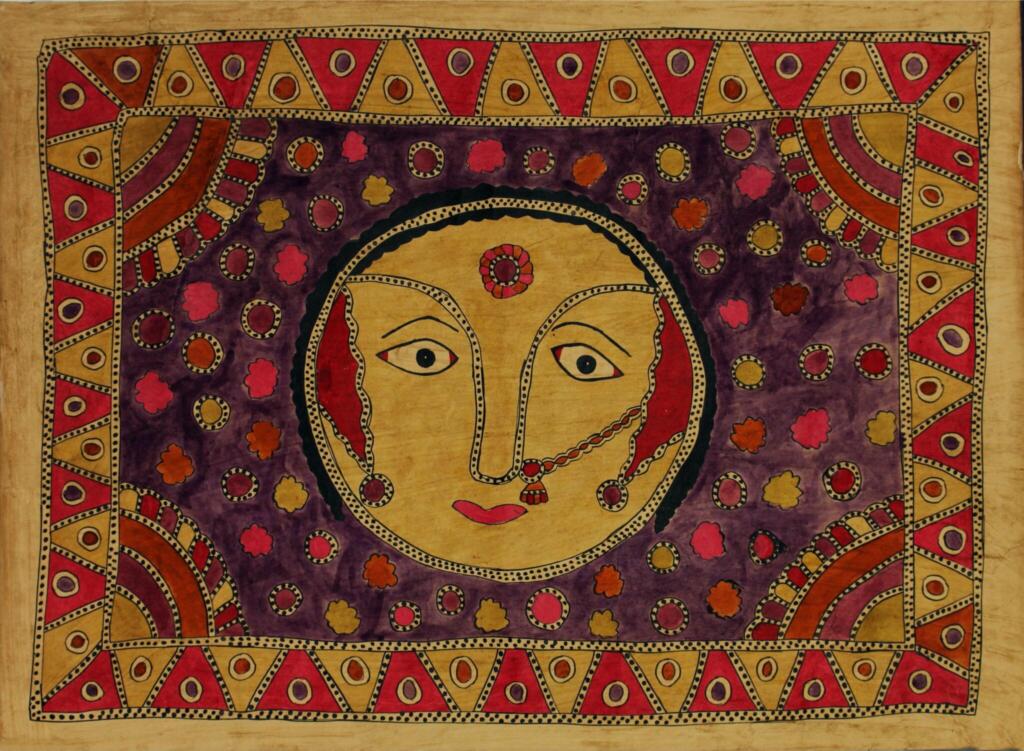
Untitled, early 21st century, unidentified artist ©️Sarmaya Arts Foundation
Agents of Change
Madhubani’s tryst with agents of change didn’t just end with its transition to paper. The art form saw an almost continual stream of outsiders coming in, contributing directly or indirectly to its evolution.
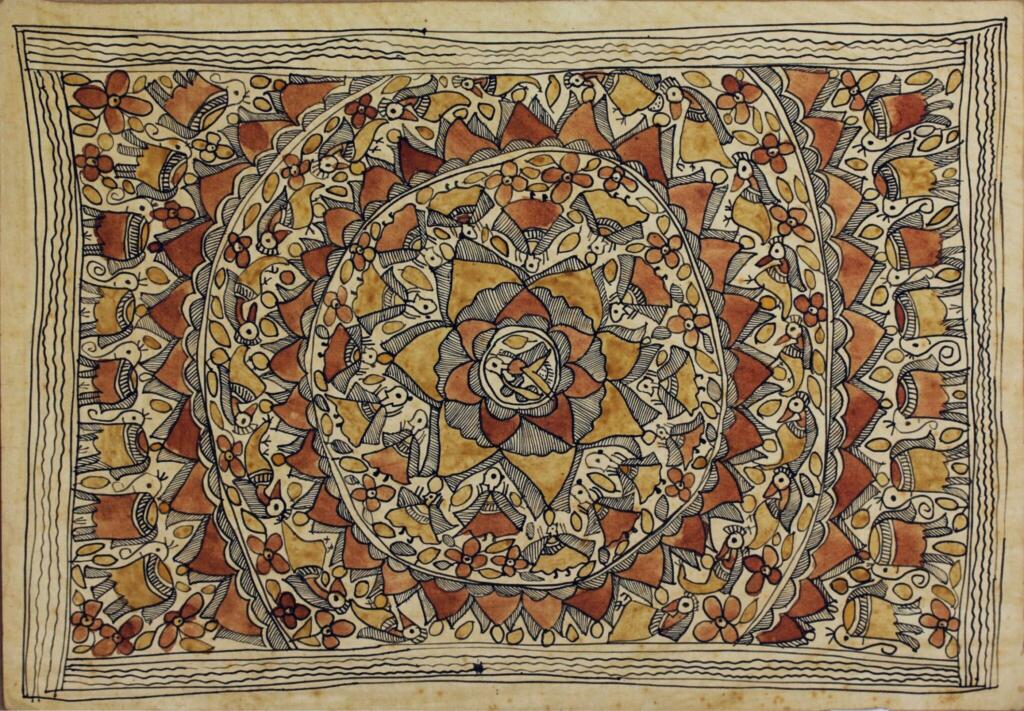
Untitled (Wedding procession cycle in Godna style), 2009, Satya Narayan Lal Karn and Moti Karn ©️Sarmaya Arts Foundation
Erika Moser, a German anthropologist and filmmaker, arrived in Mithila in 1973 and stayed in Jitwarpur for months, collecting paintings to sell back in Germany, using the profits to build a centre for women artists in the village. Moser is also credited with having encouraged Dusadh women to develop Godna painting, their own distinctive style based on traditional protective tattoos.
Yves Vequaud, a French journalist and filmmaker, arrived in Mithila in 1973, stayed for two years and made a film as well as wrote the book The Women Painters of Mithila, which for many years was considered the authoritative work on Mithila. Rich with illustrations of paintings from the masters, the book is often used as a guide for young girls in Mithila to copy drawings from. However, Vequaud’s book, often relied upon outside Mithila for cultural context on the art form, was later flagged for misinterpreting much of this very context. For one, it called Mithila a matriarchal society when in reality, the artists behind the wall paintings documented by the likes of Archer and later scholars were women observing the strictest of parda — Brahmin and Kayastha women.
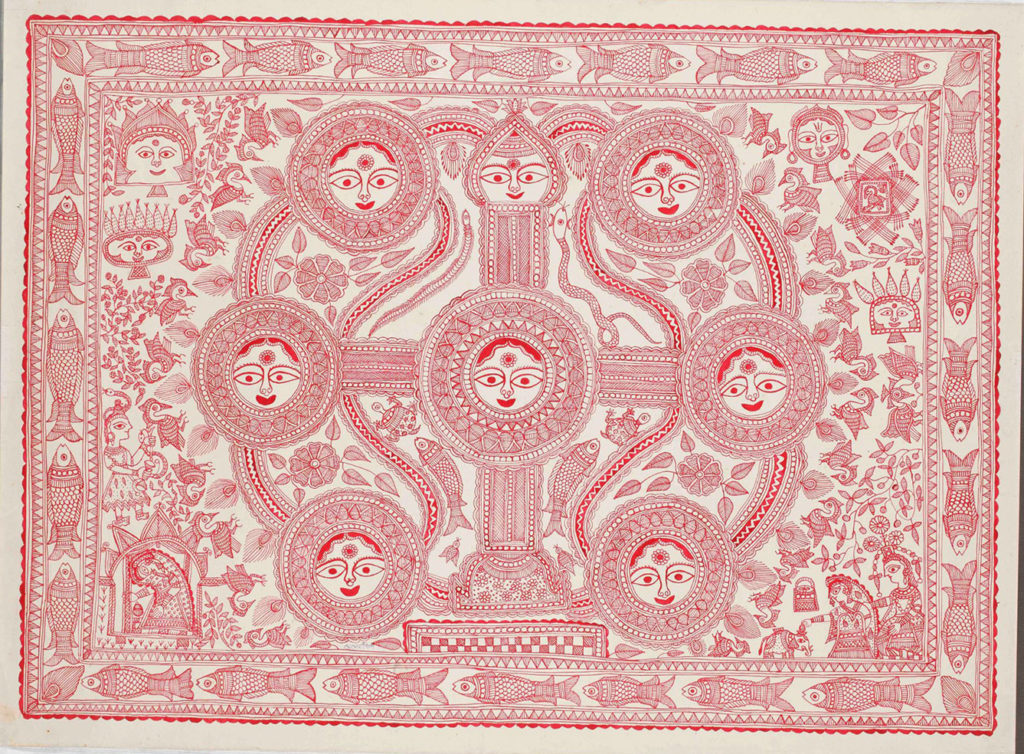
Kohbar, Dulari Devi ©️Sarmaya Arts Foundation
Yet it is not Vequaud’s account alone that has led to misunderstandings or gaps in our understanding of Mithila’s original social context. Archer himself had relied entirely on dominant caste male informants, primarily Shrotriya Brahmins and some Kayastha sources, with no input from the women painters themselves.
The most notable outsider to come into Mithila was American anthropologist Raymond Owens, who contributed significantly to the professionalisation of Mithila art. He first went to Madhubani in 1976, and continued to make extended visits until his death in 2000, staying primarily in the villages of Jitwarpur and Ranti and buying artworks from the women at much higher prices than their Delhi buyers. He then sold them in the United States and returned half the profits to the women, boosting their incomes so significantly that an artist who earlier earned Rs 15 a piece could then earn Rs 25 and an additional Rs 700 in profits. Back in the US, Owens founded the Ethnic Arts Foundation to support the continual development of Mithila, and in 2003, the EAF established a free Mithila Art Institute in Madhubani to support young Maithil painters, enrolling 25 to 30 students every year into one- and two-year programmes.
Cause and Effect
The effect of these efforts on the artists and the art form was tremendous. The women recognized the worth of their work and learned to negotiate for better prices. In the 1970s, women artists also began claiming their work by signing their names on the pieces. They did so to make sure they would be paid, but the process paved the way for the artists to both identify with their work as well as realize its value. The outsiders also contributed to the sort of subjectivity and expression that’s evolved in Mithila art over the past century. For example, Owens refrained from telling the women what to paint, but often encouraged them to move beyond traditional iconography and explore their own experiences in the paintings.
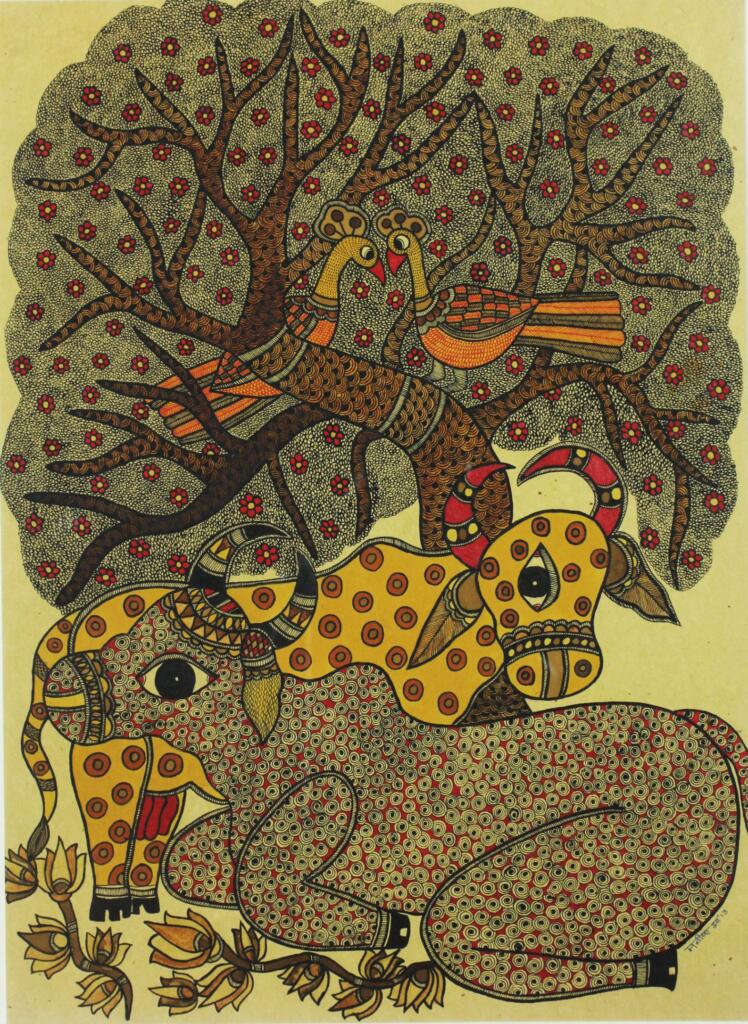
Tree of Life, 2013, Manisha Jha ©️Sarmaya Arts Foundation
Even if far detached from its ritualistic meanings, Mithila art today remains rooted in tradition. What has evolved is the vocabulary and scope of expression in these paintings as seen today – young and emerging artists from the Mithila Art Institute draw from across their life experiences to explore themes like global warming, female foeticide or bride burning, just as they would draw from mythology. In keeping with its history of being a continually evolving and living tradition, the art form has also expanded beyond its commercial purposes for educational messages on caring for pregnant women or teaching young girls to read.
From being hidden behind a veil and inside four walls, Mithila — and its women artists — is opening itself up to the world in a way it has never done before.



